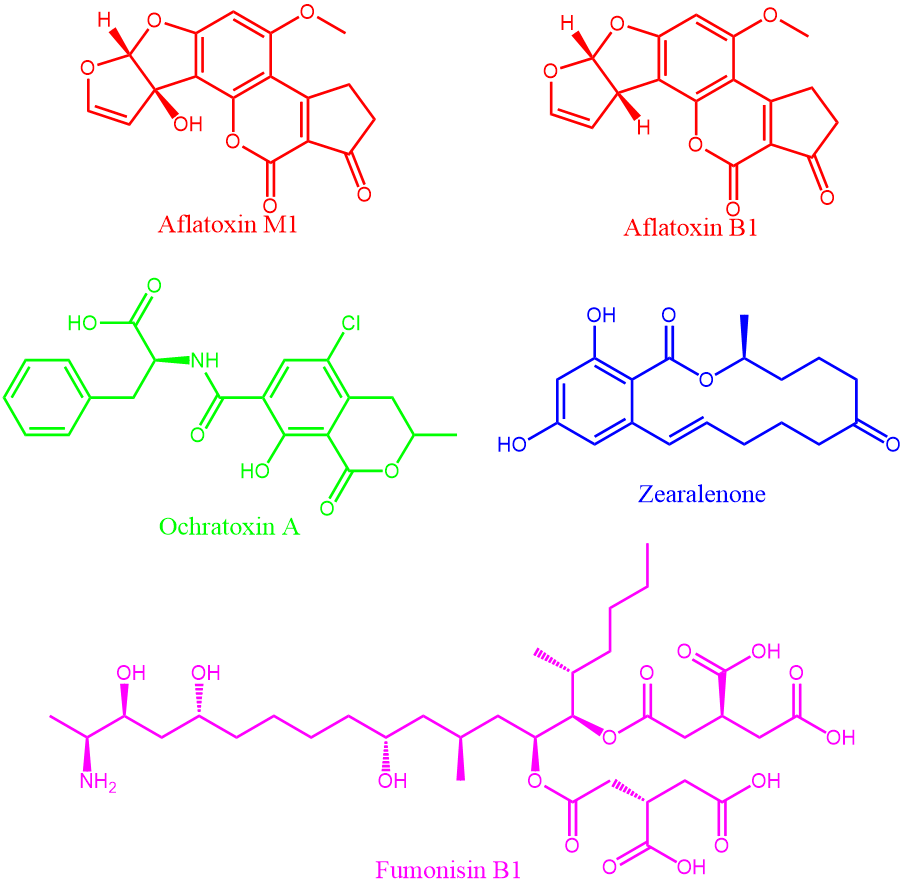Background introduction of typical mycotoxin
Aflatoxins: Aflatoxins are a group of structural related, toxic, secondary metabolites produced mainly by A. flavus and A. parasiticus. Aflatoxin-producing fungi grow on a wide variety of foods such cereals (maize, rice, barley, oats, and sorghum), peanuts, ground nuts, pistachio nuts, almonds, walnuts, cottonseeds and milk. Aflatoxins have carcinogenic, teratogenic, hepatotoxic, mutagenic, and immunosuppressive effects, with the liver the main organ affected. Aflatoxins are associated with both acute toxicity and chronic carcinogenicity in human and animal population. In humans, acute aflatoxicosis is characterized by vomiting, abdominal pain, pulmonary and cerebral edema, coma, convulsions, and even death. In animals, symptoms of gastrointestinal dysfunction, reduced reproduction, reduced feed conversion and efficiency, lowered milk and egg production, and anemia have been reported.
Ochratoxins: Ochratoxins are a group of related compounds produced by Aspergillus ochraceus, Penicillium verrucosum, and other Penicillium species. Ochratoxins have been found in a wide variety of agricultural commodities such as corn, wheat, barley, flour, coffee, rice, oats, rye, beans, peas, and mixed feeds, and are notably present in wine, grape juice, and dried vine fruits, what’s more, which also can be found in meat, milk and human milk. OTA is acutely nephrotoxic and hepatotoxic. In addition, OTA is reported to cause immunotoxicity, genotoxicity, neurotoxicity, teratogenicity, and embryotoxicity in both human and animals. OTA impacts the productivity of food producing animals by reduced feed conversion and body weight gain and may decrease egg production in laying hens.
Zearalenone: Zearalenone, a macrocyclic ?-resorcyclic acid lactone, is produced by Fusarium species, mainly F. graminearum and F. semitectum. ZEA is frequently found in corn, wheat, barley, sorghum, and rye. ZEA is classified as a Group 3 carcinogen by LARC. ZEA binds competitively to estrogen receptors (ER? and ER?) in a number of in vitro or in vivo models in various animal species, resulting in changes and lesions in the female reproductive system.
Fumonisins: Fumonisins are a group of non-fluorescent mycotoxins produced by F. verticillioides. Fumonisins can occur in maize kernels, sorghum, wheat, barley, soybean, asparagus spears, figs, black tea, and medicinal plants. FB1 is the most prevalent fumonisin in human food and also the most toxic, classified in Group 2B (probably carcinogenic) by IARC. Structurally, fumonisms are similar to sphinganine, and FB1 exerts its toxic effects by disrupting sphingolipid metabolism. Fumonisins target mainly the liver and kidney and cause severe toxicity in experimental animals. Due to their hydrophilicity, there are no carryovers of fumonisins into milk in cattle, and little FB1 accumulates in edible tissues.
Structural features of typical mycotoxin

Analysis method of mycotoxin in food
Chromatographic techniques
High performance liquid chromatography (HPLC) coupled with ultraviolet (UV), diode array (DAD), fluorescence (FLD), or mass spectrometry (MS) detectors and UHPLC or UPLC with reduced column packing material (1-2 ?m) have been developed, which can be used to detect and quantify various mycotoxins with a high sensitivity and selectivity. Additionally, gas chromatography (GC) coupled with electron capture (ECD), flame ionization (FID), or MS detectors have been used to identify and quantitate volatile mycotoxins such as TCTC and patulin.
Immunochemical methods
The principle of ELISA is based on the competitive interactions between mycotoxins (acting as an antigen) and assigned antibodies labelled with toxin-enzyme conjugate for many binding sites. The amount of antibody-bound toxin-enzyme conjugate will determine the level of color development. This technique provides a rapid, specific, and relatively easy to use method for analysis of mycotoxins in food. However, ELISA has certain disadvantages including potential cross-reactivity and dependence on a specific matrix. In addition, the kit detects only a single mycotoxin and is designed for one-time use; thus, it can be costly if one needs to test samples contaminated with multiple mycotoxins. Moreover, each test kit is specified by the manufacturer.
Rapid methods
Rapid methods are designed to be performed outside the laboratory at the site of inspection. Results are expected to be obtained within a short time, with the help of simple portable devices or even without using any instrument or readers. Besides the common ELISA procedures, many kinds of rapid visual immunoassay strips for on-site testing of mycotoxins are commercially available, including lateral flow (LFD), dipstick, and flow-through devices. A lateral flow test can provide semi-quantitative results in less than 10 min and requires no specialized equipment. The test is based on a competitive immunoassay, where a labeled antibody is used as a signal reagent. LFDs are commercially available for detection of AFs, DON, T-2 toxin, OTA, and ZEA. However, their applications in the field is limited due to numerous problems associated with the sensitivity and reliability in different matrices in addition to their high cost.
Introduction of our products
100004 - Aflatoxin M1 Rapid Test Kit
110004 - Aflatoxin M1 Rapid Test Kit (low_sensitivity)
120004 - Aflatoxin M1 Rapid Test Kit (high_sensitivity)
400001 - Aflatoxin B1 Rapid Test Kit
600001 - Zearalenone Test Kit
600002 - Deoxynivalenol Test Kit



